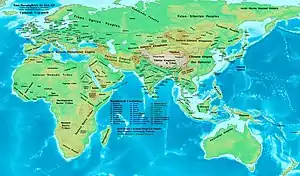Sino–Cham war
The Sino–Cham war was an invasion launched by the Chinese Sui dynasty against the Cham kingdom of Lâm Ấp in 605.
| Sui–Lâm Ấp war | |||||||||
|---|---|---|---|---|---|---|---|---|---|
 Sui empire and Lâm Ấp on the world map | |||||||||
| |||||||||
| Belligerents | |||||||||
| Lâm Ấp | Sui dynasty | ||||||||
| Commanders and leaders | |||||||||
| Sambhuvarman (Phạm Phạn Chi) |
Emperor Wen of Sui Liu Fang | ||||||||
| Strength | |||||||||
| – | 27,000 | ||||||||
| Casualties and losses | |||||||||
| Unknown | Unknown | ||||||||
Background
Around 540s, the region of Jiaozhou (northern Vietnam) fueled with unrest by the uprising of the local Li clan led by Lý Bí.[1] In 589, the Sui dynasty defeated the Chen dynasty and united China. As the authority of the Sui gradually consolidated in this region, Lý Phật Tử, the ruler of Vạn Xuân in Jiaozhou recognized the Sui overlordship. In 595, king Sambhuvarman (r. 572–629) of Lâm Ấp, a Cham kingdom with its capital located around modern-day Da Nang or Trà Kiệu, prudently sent tribute to the Sui. However, there was a myth in China which postulated that Champa was an immensely rich area, sparking the interest of Sui officials.[2]
In 601, Chinese official Ling-hu Hsi forwarded an imperial summons for Phật Tử to appear at Chang'an, the Sui capital. Deciding to resist this demand, Phật Tử sought delay by requesting that the summons be postponed until after the new year. Hsi approved the request, believing that he could keep Phật Tử's allegiance by exercising restraint. However, Hsi was accused of taking a bribe from Phật Tử, and the court grew suspicious. When Phật Tử openly rebelled early in 602, Hsi was promptly arrested; he died while being taken north.[3] In 602, emperor Sui Wendi ordered general Liu Fang to launch a surprise attack on Phật Tử from Yunnan with 27 battalions.[4] Unprepared to resist an assault of this scale, Phật Tử heeded Fang's admonition to surrender and was sent to the Sui capital of Chang'an. Lý Phật Tử and his subordinates were decapitated to preclude future trouble.[4] From recaptured Jiaozhou, Yang Chien authorized Liu Fang on a further attack on Lâm Ấp, located south of Jiaozhou.[2][5]
Course
The Chinese invasion of Champa consisted of a land force and a naval squadron led by Liu Fang.[2] Sambuvarman deployed war elephants and confronted the Chinese, but were defeated by Chinese archers.[6] The Chinese force broke through to the capital and pillaged the city. Among their spoils were eighteen golden tablets dedicated to the memory of the eighteen preceding kings of Lâm Ấp, a Buddhist library comprising 1,350 works in the local language, and an orchestra from a kingdom in the Mekong basin.[7] The Sui immediately set up an administration in Lâm Ấp and divided the country into 3 counties: Tỷ Ảnh, Hải Âm and Tượng Lâm.[8] On the route back to China, the invading force was hit by an outbreak of disease which killed large numbers of the officers and men, including Liu Fang.[2][7]
Aftermath
The Sui effort to administer parts of Champa directly was short-lived. Sambuvarman reasserted his power and sent an embassy to the Sui to "acknowledge his fault."[2] The Cham quickly regained independence during the troubles accompanying the collapse of the Sui empire, and sent a gift to the new Tang Empire's ruler in 623.[8]
References
- Schafer 1967, p. 19.
- Wright 1979, p. 109.
- Taylor 1983, p. 161.
- Taylor 1983, p. 162.
- Taylor 1983, p. 163.
- Schafer 1967, p. 17.
- Taylor 1983, p. 165.
- Schafer 1967, p. 74.
Bibliography
- Wright, Arthur F. (1979), "The Sui dynasty (581–617)", in Twitchett, Denis Crispin; Fairbank, John King (eds.), The Cambridge History of China: Sui and T'ang China, 589-906 AD, Part One. Volume 3, Cambridge: Cambridge University Press, pp. 48–149, ISBN 9780521214469
- Schafer, Edward Hetzel (1967), The Vermilion Bird: T'ang Images of the South, Los Angeles: University of California Press, ISBN 9780520011458
- Taylor, Keith Weller (1983), The Birth of the Vietnam, University of California Press, ISBN 9780520074170